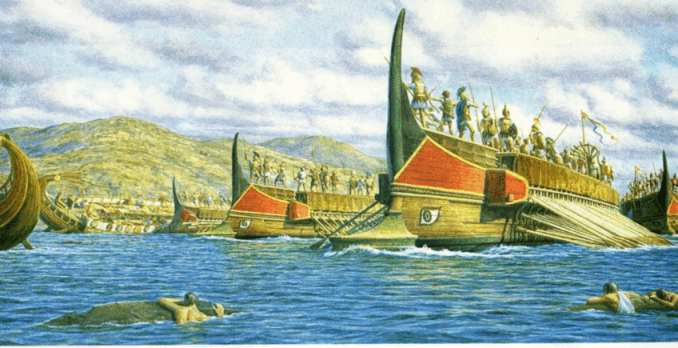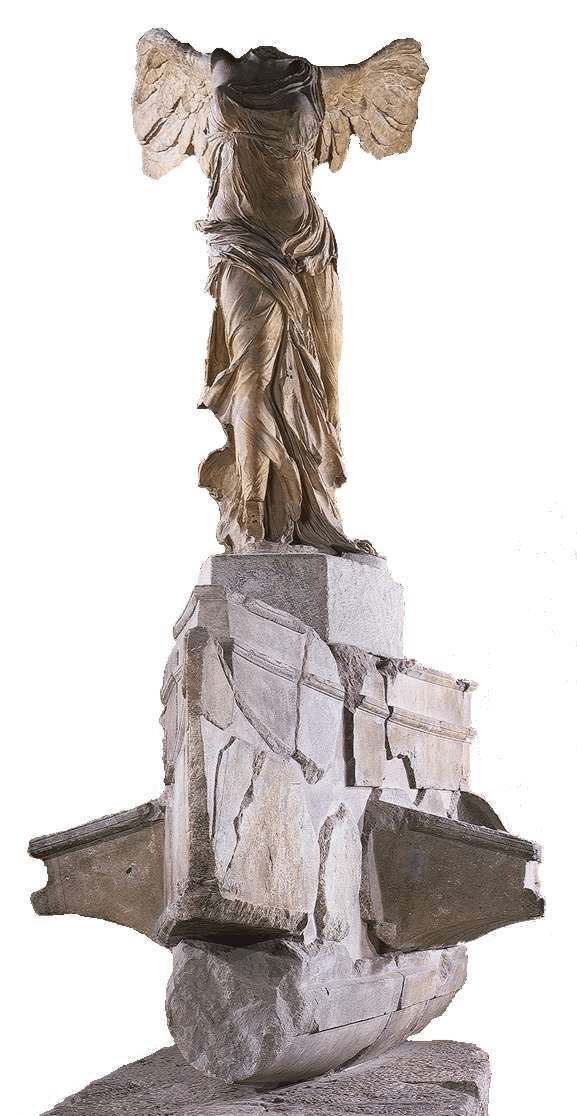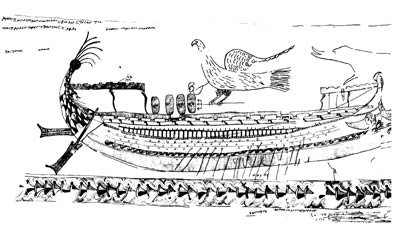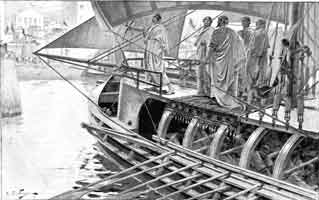.
Griechische Waffentechnologie: Kriegsschiffe
Part 2
The Crew
|
Crew |
No. |
Comments |
|---|---|---|
|
Captain |
1 |
The Trierarch, Usual a political appointee who knew very little about naval warfare |
|
Archers |
4 |
|
|
Spearmen |
14 |
|
|
Officers,highly trained sailors |
25 |
A carpenter, sail-crew, helmsman, piper. The actual command of the ship usually fell to the "kybernetes", or helmsmen (pedaliouchos, "stearing-oar holder"). Next came the "proreus", the lookout who was in charge of the foredeck The lowest ranked officer on a trireme was the pentecontarchos who was in charge of wages and the administrative duties of running a ship of war, 1 keleustes and 1 trieraules who with their voice and a musical instrument, the aulos, respectively provided the rhythm to synchronise the rowers. On each side a toicharchos superintendent the rowers. |
|
Rowers |
170-174 |
Majority of the crew arranged in three rows, poor Greek citizens of the city-state or hired rowers from elsewhere in Greece. Aristophanes mentions the olfactory disadvantages of being on bottom tier during a long voyage. 62 thranites, 58 zeugites, 54 thalamites. Rowers could not see very much from their place. They were just the “engine” of the ship. |
These numbers are an estimation (some other sources say 170 rowers), for example an old Dictionary of Greek and Roman Antiquities , eds. William Smith, LLD, William Wayte, G. E. Marindin provides as a crew 17 sailors, 1 trierarch, 2 toicharchoi, 1 keleustes , 1 trieraules, 1 eschareus and 10 epibatae (Their number dependends on the mission)
Other specialists
- elaiochreistes, "oil anointer", maybe in charge of leathern gear
- kopodetes, "oar binder", in charge of oar straps
- ergazomenoi en prymne, "workers in the stern" and ergazomenoi en prora "workers in the prow" for handling sails and lines
Pay for the rowers was 1 drachma a day (increased in 415 BC). Before it was 2 oboloi but at war time it was more. Athens undertook many small military expeditions just to keep the oarsmen fit, although as far as skill was concerned "the majority can row as soon as they get aboard since they have practised all through their life" (The "Old Oligarch").
In 431 BC, the service of 200 triremes for six months cost 800 talents or 4.8 million drachmae. In 483-410 BC Athens commissioned 1,500 triremes at a cost of 15,000 talents or 90 million drachmae. Fincances of Athens . It is remarkably that the city of Athens with an estimated population of 250000 was able to establish an industry which produced so many triremes.
The crew of more than 200 men was about two-thirds that of a modern destroyer.
Tactics

In the battle no sails were used and the mast was removed to increase the speed of the trireme.
While technology has changed the weapons of war quite drastically since the Battle of Salamis the basic needs that these weapons fulfill is still the same. The archers have been replaced by missiles, the spears are now guns. The oarsmen are now massive oil-burning boilers. The real change in naval warfare has come in tactics. Today, cruise missiles can obliterate targets hundreds of miles away. But as recently as the 1940s and 1950s the missile technology did not exist. It was the gun that was the main weapon of a ships arsenal. And because even the most powerful gun cannot reach far beyond the horizon, close in engagement was necessary. The same was true at the time of the Battle of Salamis, arrows and spears were the weapons at the time which meant that it was necessary to get very close to one's opponent in order to fight. The common tactics of the time were to ram one's opponent. Most ships at the time were equipped with a large battering ram at the bow which was used to crush the sides of an opponent. Advances in Greek warship design were aimed at achieving the speed necessary for successful ramming without loss of stability. Impact theory indicates that unless the attacker reached the critical speed of about 10 knots at the moment of impact, it would crumple, while the target vessel escaped almost unscathed! Another common tactic was to brush along the sides of the opponent's ship and snap all of the oars off. Once the ship was disabled and floundering in the waves then the over ship could move in and finish its opponent.
Athenian triremes ramming the Phoenician ships of the Persians and shearing off their oars
The trireme was well suited to the naval tactics of the 5th and 4th centuries which depended on speed, maneuverability, and ramming power. The navies of the Athenians, Syracusians and Phoenicians thus consisted of first line ships of the trireme class, with biremes as the second class, supported by the old triankonter and pentekonter types. The practice also developed towards the end of the 5th century of classifying galleys as aphract, open, or cataphract, closed, depending on whether the crew was protected or not.
Athens lost its naval power dominance after two major catastrophical events of the Peloponnesian war, the Sicilian expedition (415-413 BC) and the Battle of Aegospotami (405 BC).
Dionysius I, tyrant of Syracuse probably adopted the Quadriremes from the Phoenicians but Mnesigeiton says it was an invention of the Salaminians. Dionysius II build Hexeres, probably an invention from Syracuse. (The Invention of Catapults and the Five at Syracuse, Diod 14.41-43, 399 BC )
Special Triremes
The Paralus (gr.Paralos)and the Salaminia Triremes—the "sacred vessels" of the Athenians were used often for special occasions;
Conon’s own ship, with seven others in attendance on him and the “Paralus” put out to sea, a little cluster of nine vessels, with their full complement of men; but every one of the remaining one hundred and seventy-one vessels were captured by Lysander on the beach. Xenophon Hellenica
The Paralus was used for Athenians to visit Alexander the Great by the Athenians asking him to free the Athenians mercenaries taken as prosoners at the Battle of Granicus.
The 'sacred trireme', the Paralus, when conveying the Athenian deputation to the Festival of Delos, put in on its way at Marathon, where there was an altar of the Delian Apollo, to offer sacrifice. Demosthenes
THE DEVELOPMENT OF NAVAL SIEGE WARFARE (PDF)
THE REQUIREMENTS OF FRONTAL RAMMING. The Development of the Tetreres and Penteres (PDF)
In the Hellenistic era the tactics changed. The use of multiple oarsmen was encouraged by two important factors. Firstly, the predominant form of warfare of this period consisted in besieging cities from the sea, rather than in the inter ship warfare of the trieres era. Power and carrying capacity rather than speed became the order of the day and the extra beam required to accommodate multiply banked oars provided a wide deck to serve as a weapons platform, especially for the catapult. Although these large ships had many more oarsmen than the older trieres only one man on each or was required to be skilled, the rest could be slaves or prisoners. Athens lost its dominance as a Sea power and the Rhodians became the greatest Greek sea-power.
In principle the multiple banked system would work adequately up to the size of a sixteen. Larger galleys clearly required some extra modification.

Nike of Samothrace on the Prow of a Ship (Rhodian marble) with the battering ram. (Louvre Paris, Inv.nr. MA 2369 ). The Nike stands on a block on top of the ship but originally she was directly standing on the ship. The type of ship shown is unknown although some consider it a so called Trihemiolia Rhodian trireme who was very flexible using oars of different length. Dimensions: Height: 2.45m Width: 2.35m Length: 4.3.
Ptolemys Philopator ship had a crew of more than 4000 rowers and 2850 warriors. The emphasis returned to boarding and hand to hand fighting, rather than ramming. Because the polyremes were not intended for precision maneuvering the enclosure of all levels of oarsmen below decks was not as important as the ability to carry and employ troops. Thus the Athenian trieres of the 4th century would expect to carry around 14 marines whereas a roman quinqereme of the mid 3rd century would carry 120 marines in addition to the oarsmen.
Even if triremes were not so important in Roman times they were used until c. 400 AD. It was therefore a ship that was used for a period of almost 1000 years!
Paraleipomena
Every ship at Athens, as in modern times, had a name given to it, which was generally of the feminine gender, whence Aristophanes (Eq. 1313) calls the Triremes parthenou, and one ship, the name of which was Nauphante, he calls the daughter of Nauso. The Romans sometimes gave to their ships masculine names. The Greek names were either taken from ancient heroines such as Nausicaa, or they were abstract words such as Euploia, Therapeia, Prnoia, Swzousa, Hgemonh etc. In many cases the name of the builder also was added. William Smith, A Dictionary of Greek and Roman Antiquities, John Murray, London, 1875. The names of several hundred fighting ships are preserved on an inscription in Athens. A fascinating list!
From a lecture: Neocles, according to Plutarch, recognized the dangers of Athenian political life and warned [his son] Themistocles about his ambitions. One day when the two walked along the beach at Phaleron, where Athenian ships had once been slip-hauled. Neocles noted the rotting hulls of some old triremes, lying there abandoned on the beach. "That, my boy is just how the Athenian people treat their leaders when they have no further use for them."
The Persian heroine Artemisia a woman commander of a part of the Persian navy An advice she has given for Xerxes: “Tell the king that it is I who say this and clearly I have not been lacking in courage against the Greeks. But, I council you not to offer their fleet a battle. The Greeks are much stronger at sea than us, just as men are stronger than women. So why endanger yourself at sea? You have possession of Athens, the aim of this campaign. On land, no man stands against you. You could even advance into the Peloponnese and easily gain victory. The Greeks cannot hold a united front and will scatter to their individual cities. I hear the Greeks on Salamis are short of food and if you lead your army into the Peloponnese, then those Greeks will be fully occupied and have no wish to support the Athenians in a sea battle. But to push for a naval confrontation now risks great harm to both your fleet and your land army”
"From her bold actions in the earlier battle, Artemisia already had a bounty price on her head from the Greeks: 10,000 drachmas for anyone who could take her alive." In the battle an Athenian galley bore down on her ship. Her escape to the open sea was blocked by other Persian ships, each endeavouring to pass the other. With the imminent threat of a Greek assault on her stern, she quickly decided to surge on at full speed. Ahead, she spied the flagship of the Calyndian contingent, led by King Damasithymus. Calynda lay on the border of Lycia and Caria and it may well be that Artemisia held a personal grudge against the Calyndian king. Without giving any warning, Artemisia’s ram splintered the ship with such an impact that it sank immediately, with few survivors. Seeing this dramatic action, the captain of the Greek ship pursuing Artemisia believed she must have been a friendly ship or a deserter from the Persians and so broke off his attack. Xerxes similarly misunderstood the target of Artemisia’s attack and praised her for her aggression. ‘My men have become women,’ he growled at his commanders, ‘and my women men.’ Ameinias, the captain of the Greek ship that mistook Artemisia’s identity, was furious when he learned the truth after the battle," having missed his chance at the bounty. Thus, in the confusion and chaos attending the naval battle at Salamis, she was able to get away. .” [Tim Neward, Women Warlords, Blandord, 1989, pp. 53-60.]
Again, we are indebted to those who took pen in hand to write a humorous account of just how close and crowded these conditions were. Aristophanes, in his comedy play The Frogs, refers to the common habit of the upper banks of oarsmen "farting in the face of the thalamite." http://www.crystalinks.com/rometransportation.html
...among which it is reported that Xanthippus, the father of Pericles, had a dog that would not endure to stay behind, but leaped into the sea, and swam along by the galley’s side till he came to the island of Salamis, where he fainted away and died, and that spot in the island, which is still called the Dog’s Grave, is said to be his. Plutarch Themistocles
|
Embolon |
ship’s beak or ram. |
|
Nautes |
sailor |
|
Nautikon |
fleet; navy |
|
Pentekontoros |
galley with fifty oarsmen on one level. |
|
Penteres |
quinquereme; oared warship rowed by five oarsmen on either two or three levels |
|
Pleroma |
ship's crew |
|
Ploion |
ship |
|
Thalamios |
oarsman on lowest level of a trireme. |
|
Thranites |
upper level rower on a trireme |
|
Triakontoros |
thirty oared war ship |
|
Trieres |
trireme; oared warship with three levels of rowers. |
|
Trierarchos |
(1) captain commanding a trireme; (2) wealthy citizen providing a trireme at his cost |
|
Zygios |
middle level oarsman on a trireme |
Comments to Barry Strauss, The Battle of Salamis. The Naval Encounter That Saved Greece -- and Western Civilization
Quotations
For so the Athenians had marked them before with a Samaena, which is a sort of ship, low and flat in the prow, so as to look snub-nosed, but wide and large and well-spread in the hold, by which it both carries a large cargo and sails well. And it was so called, because the first of that kind was seen at Samos, having been built by order of Polycrates the tyrant. Plutarch, Pericles
It was intended to build 1000 warships larger than triremes in Phoenicia, Syria, Cilicia and Cyprus for the expedition against the Carthaginians and the other inhabitants of the coastal area of Africa, Spain and the neighboring coasts as far as Sicily; to build a coastal road in Africa as far as the Pillars of Heracles, and, as required by such a large expedition, to build harbors and shipyards at suitable places Alexander's last plans
He who most distinguished himself was Brasidas. Captain of a galley, and seeing that the captains and steersmen, impressed by the difficulty of the position, hung back even where a landing might have seemed possible, for fear of wrecking their vessels, he shouted out to them, that they must never allow the enemy to fortify himself in their country for the sake of saving timber, but must shiver their vessels and force a landing; and bade the allies, instead of hesitating in such a moment to sacrifice their ships for Lacedaemon in return for her many benefits, to run them boldly aground, land in one way or another, and make themselves masters of the place and its garrison.
Not content with this exhortation, he forced his own steersman to run his ship ashore, and stepping on to the gangway, was endeavouring to land, when he was cut down by the Athenians, and after receiving many wounds fainted away. Falling into the bows, his shield slipped off his arm into the sea, and being thrown ashore was picked up by the Athenians, and afterwards used for the trophy which they set up for this attack. Thucydides Book 4
References
Athenaeus, The Deipnosophists, Book 5, Section 203f–204b (2:421–425, Loeb Classical Library No. 208, Harvard University Press, 1987)
Brewster, Frank, "The Arrangement of Oars in the Trireme," Harvard Studies in Classical Philology 44 (1933) 205-225.
Cook, A.B. & Richardson, W. "Triremes," in Classical Review 19 (1905) 371-77.
Holladay, A.J. "Further Thoughts on Trireme Tactics" G&R Oct., 1988 35,2 149-151.
Welsh, Frank, Building a Trireme, London, 1988.
Kopecky, Josef, Die attischen Trieren, Leipzig, 1890.
Anthony J. Papalas, Development of the Trireme," Mariner's Mirror, 83.3 (1997), 259-271 and "Polycrates of Samos and the First Greek Trireme Fleet," Mariner's Mirror, 85.1 (1999)
Modern Reconstruction of a Trireme, the so called Olympias . How maybe a Trireme really was.
The Ram of the Olympias a modern Trireme Reconstruction
Construction of the Hull
Physics of Rowing
http://www.lgpn.ox.ac.uk/image_archive/inscriptions/ipus1.html One of the naval lists of the city of Athens in which the warships and the parts of their equipment are enumerated (detail) 349/8-348/7 BC. Athens Epigraphic Museum
Giant Hellenistic warships with more than 7000 crew members! , The giant Syracusia transport ship
Military Technology (Armor, Ships, Catapults, Polybola, Siege and Radiation Weapons, Links)
LINKS
http://cma.soton.ac.uk/HistShip/SHLECT26.HTM
http://www.atm.ox.ac.uk/rowing/trireme
Ancient Greek Naval Warfare
The Nike of Samothrace landing on a war-ship
Hermitage Museum Pottery
Images of a modern Trireme in Greece
Harbours of Piraeus: Cantharus, Zea, Munichia
PERSEUS
http://www.perseus.tufts.edu/cgi-bin/image?lookup=1999.04.0063.fig20217 Prow of Trireme. (From Greek terra-cotta vase in British Museum.)
Xenophon Anabasis
It is a long day's journey for a trireme to row from Byzantium to Heracleia
Aristotle, Metaphysics , logic and triremes
Again, if all contradictory predications of the same subject at the same time are true, clearly all things will be one. For if it is equally possible either to affirm or deny anything of anything, the same thing will be a trireme and a wall and a man; which is what necessarily follows for those who hold the theory of Protagoras. For if anyone thinks that a man is not a trireme, he is clearly not a trireme; and so he also is a trireme if the contradictory statement is true and the result is the dictum of Anaxagoras, "all things mixed together" ; so that nothing truly exists. It seems, then, that they are speaking of the Indeterminate; and while they think that they are speaking of what exists, they are really speaking of what does not; for the Indeterminate is that which exists potentially but not actually.But indeed they must admit the affirmation or negation of any predicate of any subject, for it is absurd that in the case of each term its own negation should be true, and the negation of some other term which is not true of it should not be true. I mean, e.g., that if it is true to say that a man is not a man, it is obviously also true to say that he is or is not a trireme.Then if the affirmation is true, so must the negation be true; but if the affirmation is not true the negation will be even truer than the negation of the original term itself
Images
http://www.csad.ox.ac.uk/CSAD/Images/400/Image427.html Lower section of an Athenian decree from the Piraeus with interesting regulations concerning the minimum crew size of triremes in the Athenian fleet.
Decree of the Athenian people assembly (Demos) ordering, after a proposal of Themistocles, the evacuation of Athens, the mobilization of the fleet and other measures, before the Persian invasion in Attica in 480 BC (3rd cent. BC copy from Troizen). Height 0.61, width 0.37, thickness 0.09 m. from Epigraphical Museum
Corinthian Ship Image on an Aryballos
Trireme sheds in Piraeus , Trireme storage and repair building in the Piraeus , Piraeus
Detail from the grave marker of Demokleides the son of Demetrius. The prow of a trireme can be made out in front of the hoplite Demokleides, who is sitting on a rock
The Battle of Salamis: The Naval Encounter That Saved Greece - and Western Civilization , Barry Strauss, New York: Simon and Schuster, 2004. (A selection (PDF File)
Giant Triremes

The “ISIS” Trireme from the Nymphaion fresco assumed to be 60 m long (width and height: around 15 m)
The Isis Ship of Ptolemy II Philadephus (PDF)
Morrison, GROW, 207-214 (Nymphaion Fresco) , W.M. Murray, "Observations on the "Isis Scraffito" at Nymphaion," 1-14 , N. Grac, "Ein neu entdecktes Fresko aus hellenistischer Zeit in Nymphaion bei Kertsch," in Skythika, Bayerische Akademie der Wissenschaften, Phil-Hist. Klasse, Abhandlungen, Neue Folge,. Heft 98, (1987) 85-95.
Roman Navy: F. Meijer, A History of Seafaring in the Classical World (London, 1986) 147-66; and 167-85. (PDF Files)
| Ancient Greece
Science, Technology , Medicine , Warfare, , Biographies , Life , Cities/Places/Maps , Arts , Literature , Philosophy ,Olympics, Mythology , History , Images Medieval Greece / Byzantine Empire Science, Technology, Arts, , Warfare , Literature, Biographies, Icons, History Modern Greece Cities, Islands, Regions, Fauna/Flora ,Biographies , History , Warfare, Science/Technology, Literature, Music , Arts , Film/Actors , Sport , Fashion --- |


